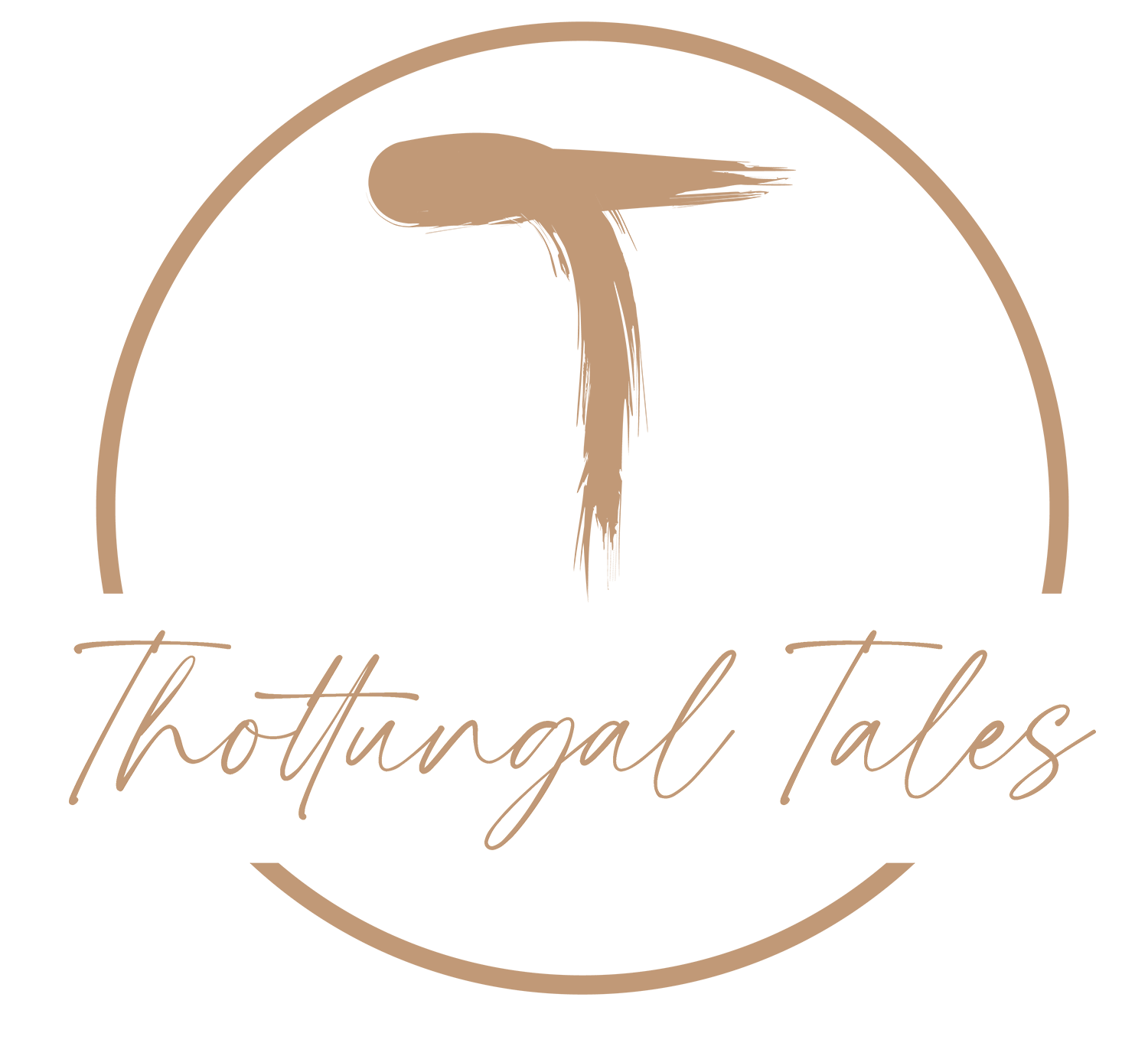We have a look around the port city of Kochi, stroll through the harbour markets selling baskets of squirming crabs, sandal oil, spices, and, side by side with the food, traditional costumes for little girls – starched, creamy white dresses, skirts and blouses, embroidered with a shimmering gold trim. Along the shoreline we marvel at the men jogging impossibly up the steeply-pitched poles that hoist their China nets into and out of the harbour. And then we walk to the open air cooking school of Minnie Paul for the beginning of what we’ve really come to do in Kerala. Taste, learn, cook.
This was day one of a two week trip to Kerala state, the narrow band of southwestern India that restsbetween the Arabian Sea and the Western Ghats mountain range. That geography of ocean and mountains would be a constant companion on our trip – one that began in a splendid kitchen garden surrounded by neatly labelled trees, bushes, herbs, launching a culinary tour of Kerala with the banana leaf feast.
“It’s a lot of work, let me tell you,” Minnie Paul informed our group. Known as the Sadya, this was a vegetarian party meal she wouldn’t ordinarily serve at her school. Time consuming, labour intensive, and reserved for celebrations (particularly the Hindu festival of Onam). But Joe Thottungal, chef-owner of Ottawa’s Coconut Lagoon Restaurant, had asked her, nicely (apparently) and repeatedly. He wanted this Canadian group he was hosting – fans of his south Indian restaurant, on a spice tour of his home state – to experience a traditional harvest feast.
Minnie Paul and her staff had given in to Joe’s pleas, and had been up since the wee hours preparing.
Much to our pleasure.
After a wander through the garden, followed by an introduction to the typical ingredients, classic methods and critical spices that inform the cuisine of Kerala, we sat down to tables spread with white cloths and dark green banana leaves. And then to the parade of side dishes. Rice piled at the centre of the green canvas was methodically surrounded with a smorgasbord of colour, dollop by dollop: the scarlet beetroot pachadi, glistening dark brown chutneys, a pile of banana chips. Mildly spiced curries were dropped on the leaf; cabbage thoran with grated coconut, mustard seed, curry leaves; pumpkin and red pea with fresh ginger in a coconut-cumin sauce; spicy pickles; coconut chutney, and crisp pappadum. A traditional dessert called Payasam was reminiscent of rice pudding, but made with mung beans mashed and sweetened with jaggery, cooked to the consistency of a thick milkshake, and crowned with roasted coconut meat.
We were to encounter Sadya one more time, toward the end of our two weeks in Kerala, at a wedding feast in a teak heritage home in the village of Kumarakom. But it wasn’t as good as the first.
Somewhere in the middle, in the town of Kumily, was perhaps our most memorable meal. It had been a head-down, huffing walk up a steep hill, but when we arrived, hot and hungry, at the spice farm home of Joykutty Philip and family we were greeted to an oasis of green – and to a driveway spread with a tarpaulin of drying peppercorns and cloves. There was another tour of splendid gardens, and then a cooking demonstration. We took turns making chapatis and grating fresh coconut. We picked peppercorns. And we ate a family meal beneath a canopy surrounded with the garden that produced the
spices, herbs, fruits and vegetables we were tucking into. A thoran of tender jackfruit and another dry-fry made with the mature jackfruit from the trees just behind us. There was an egg curry and a fish curry in which black tamarind starred. With these came lemon rice and a Kerala style tapioca dish, stained yellow with turmeric, flavoured with shallots, grated coconut, green chilies, mustard seed, curry leaf. More curry leaf was in a beef coconut curry. And more still, fried in coconut oil, was used as a garnish. “Without curry leaf,” chef Joe tells us, “there is no Kerala cuisine.” It was his oft-repeated, Om-like mantra.
Inspired by this lunch, there was a shopping spree in Kumily. On Lake Road, in a narrow store called Spice Cuisine. In my basket went peppercorns, cumin seed, black tamarind, cinnamon bark, nutmeg, mace, turmeric root, cashews, and five packages of green cardamom pods. Some to give away, more to keep.
When I’m feeling glum I’ve taken to snorting my Kerala cardamom stash. I uncap the tin in my spice drawer, sink my nose in and breathe deeply. The smell takes me back to the happy day spent over eating and shopping in Kumily, and also to the Gravol-popping journey through the Cardamom Hills the following day. We were in a bus destined for the tea plantations of Munnar, shepherded by a very fine fellow called Joy. But we were allowed to pause whenever there was a spot on the side of the road, step off the bus and take in the aroma.
After Kumily we were climbing again, to the region some call India’s Scottish Highlands, the plantations first established by a Scotsman called Munroe in the late nineteenth century.
It’s a spectacular drive. The tea trees that cling to the steep slopes are so lush they look fake. As though someone has spread a monstrous emerald green carpet over these hills. We’re headed to the Mountain Club Resort, once a summer estate of the quondam British Government in South India. Joy is navigating the serpentine road that hugs the hills. He honks at every bend. This he does, it would seem, to announce his intention to take the blind hairpin turn and his wish that anyone he might meet with a similar plan, coming in the opposite direction, be armed with that knowledge. The law of the louder horn seems to prevail and oncoming coaches/cars/motorbikes/tuk-tuks on the many parts of the road that are single-track, reverse down the hill to a small lay-by in order to let us pass. Joy toots his thanks and we breathe again. Till the next twist in the road.
Fortunately, there is distracting beauty around us. The new air is cool and clean. Mist hangs over the mountains. We find sweaters in our bags. The sculpted rows of emerald bushes connected with narrow spiral passageways remind me of the ornamental yew mazes of Tudor gardens – had the mazes the added challenge of being cliff bound and 2200 metres above sea level. Except here in Munnar, the trees that would – if left to their own devices – grow tall and tree-like are kept as pruned bushes, their tops about shoulder height, and here the green is interrupted with granite outcrops and the occasional spindly betel nut tree, planted purposefully to help prevent erosion. Every few miles, the unrelenting green is interrupted with flashes of red, orange, blue, yellow. A rainbow of saris worn by the tea pluckers makes for a striking contrast.
I miss the colours of Kerala. The countryside, the mountains, the gardens, the sea. And I miss the crush of jostling bodies in the narrow alleys of the markets, the chattering, the endless horns, the furious intensity of street life. I miss the smells – of petrol mingled with toasted cumin, cardamom, incense, roasting nuts, pickled fruit. But mostly I miss Kerala breakfasts. Each morning a new treat to discover. Watermelon juice. Great rounds of crisp dosa served with the vegetable-tamarind stew called sambar. Or filled with potato masala. Uppumavu made with semolina, mustard seed, ginger and onion. The steamed rice noodle nests called Idiyappan sprinkled with toasted coconut and served with a side of egg masala. Aloo booda – potato balls coated with chickpea flour, flecked green with chilies. Idli with dollops of coconut chutney. Puttu made with rice flour and grated coconut and eaten with sweet bananas. Kallappam, rice pancakes studded with shallots and cumin seed. And my favourite – the addictive vada, Kerala’s breakfast donuts, of lentils, soaked, ground, fermented, seasoned with mustard seed and curry leaf, and sometimes with chillies and shallots, shaped into rounds, poked with a thumb, and deep fried. I tried to limit myself to three a day. And now, as I face my toasted Montreal bagel on a cold November morning, I wonder why.

